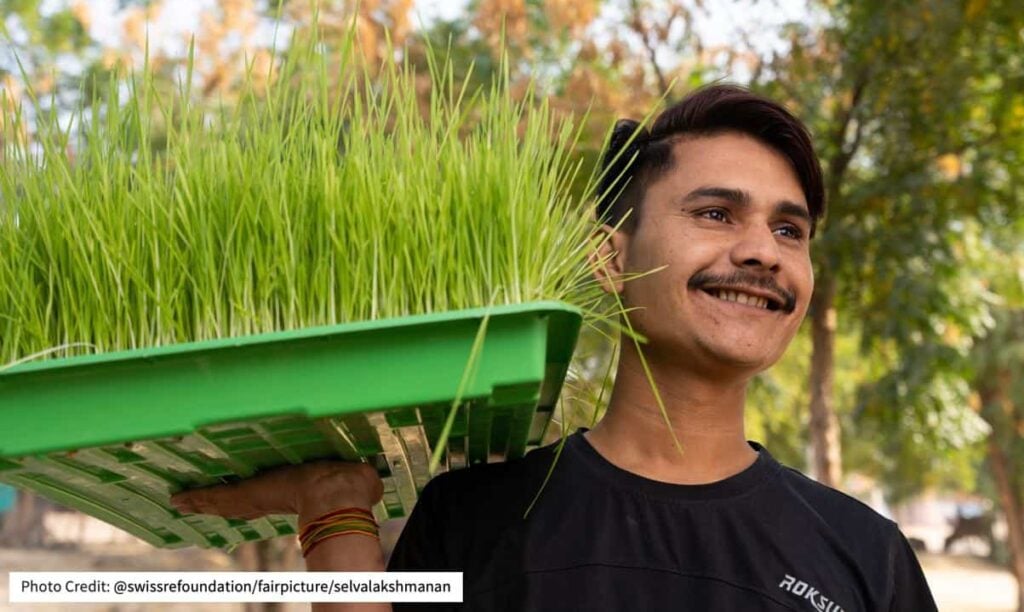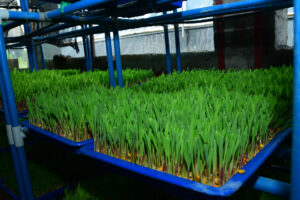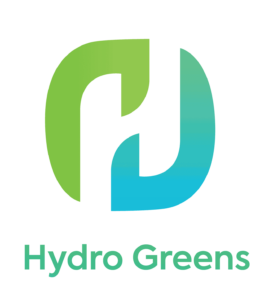Hydrogreens Agri Solutions
There is an estimated 40% shortage of green fodder (260 Million tons) that is affecting 70 million farmers involved in livestock farming in India – 70% of the farmers are women. Moreover, the production loss in dairy animals amongst high milch animal density regions of India is computing an estimated loss of 15.25 billion between 2020 and 2029, which will further accentuate in the coming time.
About the Project
To target these issues, Hydrogreens provides fodder stations to produce highly nutritious hydroponic green fodder that are natural, palatable, digestible and available all year-round for livestocks. It is a localised means for dairy farmers to grow fresh fodder. As the fodder units are solar-powered, they are a low-cost micro climate-controlled space and can be installed in a 12 sq ft area to grow sufficient fodder for four cattles in house. It has the necessary infrastructure to operate in warm temperatures of 40℃ to 50℃ while only using half a bucket of water. This is a critical avenue for cattle farmers and customers to acquire nutrient rich green fodder even during the hot summer months. This also ensures an increase in milk yield and fat content enabling higher income along with reduction in concentrate feed expenses, that it considerably reduces production cost of per litre milk and ensures an ROI within a year. In order to reduce upfront cost of capital to dairy farmers, Hydrogreens has pioneered the retail sale of fodder through a fodder station model. The fodder growing house, known as the Kambali unit, also produces crops such as wheatgrass and mushrooms.
Story from the Field
Parmila has been part of the Bahula dairy farm supported by Urmul Seemant, in Bajju village, Rajasthan. Deficient rainfall in Bajju in the past has rendered the area dry. Parmila, along with others, have been using the green fodder from Hydrogreen fodder station since 2020 and are extremely satisfied with the results. They have experienced significant increase in yield, from 3 kgs per tray 4 kgs per tray, with a total yield of up to 30 kgs daily – sufficient for 7 cattles. Due to the lack of rainfall, Parmila and other workers at the Urmul dairy have found it extremely difficult to make enough green fodder to feed their cattle. Therefore, comparatively lower water usage in Hydrogreens has been critical in the face of a water shortage in the village of Bajju. Furthermore, the abundance of fodder has reduced the cost spent on concentrate feeds and increased the earnings through increased yield and fat content. During the rainy season, the Hydrogreen hydroponics system grows jowar, wheatgrass, oats and barley. Parmila has added that hydroponics is a crucial infrastructure for continued success in cattle harvesting in the changing and unpredictable climate.
Intersectionalities
An increasing population demands higher water usage in agriculture regardless of the global and national water crisis in India. Hydroponic systems use up to 95% less water without pesticides, which makes it a reliable and affordable source of livestock feed. Conventional farming practices will require 1 hectare of land and 1000L of water to produce one litre of milk, while in comparison, hydrogreens hydroponic system only requires 15 sq ft of space and 20L of water, as each layer can stack onto one another. This frees up land to remain in its natural state, and be available for agriculture and livelihood generation.
Ruminant livestock has been recognised as a major contributor to greenhouse gases. For instance, an average lactating cow or buffalo in India emits around 200 litres of methane daily. This number increases among malnourished cattles during rumination. As green fodder increases the nutritional value of the feed, it improves the nutritional intake of cattles and thus reduces the methane emitted during rumination. Therefore, Hydrogreen’s hydroponic system is the easiest way to access green fodder round the year directly from one’s home.
Scalability
According to a study on the regions with low green fodder availability; district-level distribution of households purchasing green fodder; and district-level mean annual, India has an estimated market potential of USD 3.2 billion, where such hydroponic units can produce 28-30 kg fodder daily. The hydrogreens fodder units have been installed in Odisha, Rajasthan, Gujarat, Karnataka, UP, Meghalaya & Andhra Pradesh. Some challenges they face are in marketing; changing the perception of people on green fodder being easily available; forging partnerships with government run dairy cooperatives; and availability of financing to underserved communities.
With a potential payback period of about 20 months, such solar-powered hydroponic systems can be scaled considerably through collectives like farmer producer organisations (FPOs) and self-help groups (SHGs) with proper doorstop financing solutions. Under the program ‘Powering Livelihoods’ run by Villgro Innovations Foundation jointly with CEEW, we are making a conscious effort to create this ecosystem for doorstep financing and drive awareness about this product. Many entrepreneurs are also coming forward to set up fodder stations that offer fodder as a service catering to all livestock farmers.





















